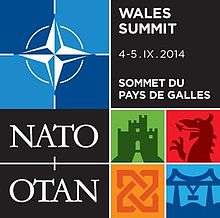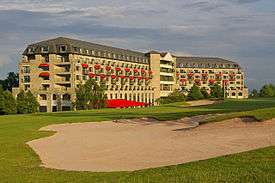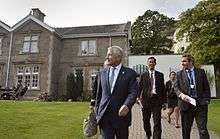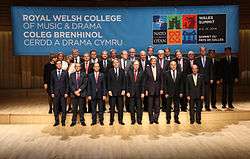2014 Wales summit
| NATO Summit Wales 2014 2014 Newport Summit | |
|---|---|
 Logo of the 2014 Wales Summit | |
| Host country | United Kingdom |
| Date | 4–5 September 2014 |
| Venue(s) | Celtic Manor, Newport |
| Cities | Newport, Cardiff |
| Website | NATO Summit Wales 2014 |

The 2014 Wales Summit of the North Atlantic Treaty Organization (NATO) was a meeting of the heads of state and heads of government of the North Atlantic Treaty Organization, held in Newport, Wales on 4 and 5 September 2014. Such summits are sporadically held, and allow leaders and officials from NATO Allies to discuss current issues of mutual concern and to plan strategic activities. The 2014 summit has been described by Admiral James Stavridis as the most important since the fall of the Berlin Wall.[1]
Background
The summit was hosted by British Prime Minister David Cameron. Attendees included Canadian Prime Minister Stephen Harper, US President Barack Obama, German Chancellor Angela Merkel, French President François Hollande, Italian Prime Minister Matteo Renzi and Spanish Prime Minister Mariano Rajoy.

There were another 180 VIPs, and 4,000 delegates and officials from approximately 60 countries.[2]
The official logo for the summit included a panel with four quadrants, each bearing a stylised symbol of Newport or Wales: a Celtic knot, the Welsh Dragon, Newport Transporter Bridge and a Welsh castle.[3] The entrance to the venue was fronted by a full-scale replica of a Eurofighter Typhoon.[4][5]
Agenda

World leaders met at the Celtic Manor, and informally at other locales in and around Cardiff. They discussed ongoing events in the world, such as terrorism, cyber warfare, and other areas of national security interest to the member states.
Ukrainian President Petro Poroshenko had a joint discussion with EU big four leaders and US President Barack Obama before the official start of the Summit, to discuss the crisis with Russia.[6][7][8]
Outcomes
.jpg)
The following declarations and agreements were made at the Summit:
- Wales Summit Declaration[9]
- Joint Expeditionary Force agreement[10]
- Armed Forces Declaration[11]
- Joint Statement of the NATO-Ukraine Commission[12]
- Declaration on Afghanistan[13]
- The Wales Declaration on the Transatlantic Bond[14]
At the end of the summit Ukrainian President Poroshenko announced a ceasefire which had been agreed with one of the leading pro-Russia separatist leaders, under terms proposed by Russian President Vladimir Putin, which was cautiously welcomed by NATO leaders.[15]
For the first time, the Allies formally pledged to aim to move towards what had previously been an informal guideline of spending 2% of their gross domestic products on defense, and 20% of that on new equipment.[16] For countries which spend less than 2% they agreed upon that these countries "aim to move towards the 2% guideline within a decade".[9] In 2015, five of its 28 members met that goal.[17][18][19] At the beginning of 2018, eight of the 29 members either were meeting the target or were close to it; six others had laid out plans to reach the target by 2024 as promised; and Norway and Denmark had unveiled plans to substantially boost defense spending (including Norway's planned purchase 52 new F-35 fighter jets.[20]
Further outcomes were the development of the Readiness Action Plan and the Defence and Related Security Capacity Building Initiative.[21]
Criticism
.jpg)
Walther Stützle, Social Democratic Party of Germany former defence secretary of state and former head of the Stockholm International Peace Research Institute, criticised the summit agenda for its focus on military details and not political perspectives. Stützle said that the Russian Federation was not a military threat to NATO but criticised that new NATO members' policies were not détente and negotiation with the Russian Federation.[22]
Protests, demonstrations and marches took place in Newport and Cardiff involving several hundred people, though the turnout was much lower than predicted.[23]
Security

In both Newport and Cardiff, road closures and security measures, starting weeks in advance of the summit, created widespread disruption.[24] Thirteen miles (21 km) of security fencing, 2.7 m (9 ft) high, was erected around the Newport hotel venue[24] and 10 miles (16 km) of fencing put up around Cardiff city centre, creating what was described as a "ring of steel".[25] Businesses in the vicinity of security fencing in Cardiff reported a drop in trade by up to a third.[26] This fencing was based on, and expanded, the 'National Barrier Asset' which is held in reserve for similar events.
Security included around 9,500 specially trained police officers patrolling the streets of the two cities, military helicopters including US Osprey V22s and the Royal Navy's new £1bn Type 45 destroyer HMS Duncan.[27]
Leaders and other dignitaries in attendance
Member states
|
|
Non-member states and organisations
|
|
NATO Foreign ministers

.svg.png)








References
- ↑ Hjelmgaard, Kim (31 August 2014). "NATO summit 'most important' since fall of Berlin Wall". USA Today. Archived from the original on 1 September 2014. Retrieved 9 December 2015.
- ↑ "Nato Wales 2014: Newport summit in numbers". BBC News. 29 August 2014. Retrieved 30 August 2014.
- ↑ "Nato summit logo features Newport's Transporter Bridge – BBC News". BBC. Retrieved 9 December 2015.
- ↑ "Final preparations for Nato summit in Newport – BBC News". BBC. Retrieved 7 February 2016.
- ↑ "Summit Wales 2014 – Day 1". Getty Images. 4 September 2014. Retrieved 7 February 2016.
- ↑ "Poroshenko to brief world leaders before NATO summit". Channel NewsAsia. 4 September 2014. Retrieved 8 September 2014.
- ↑ "Obama, Cameron, Merkel, Hollande y Renzi se reunirán con presidente de Ucrania – Noticias | TeleticaMovil". teletica.com. Retrieved 12 September 2014.
- ↑ "Ucraina. Renzi arriva al vertice Nato, summit G5 su Ucraina apre incontri". Internazionale (in Italian). Rome. 4 September 2014.
- 1 2 North Atlantic Alliance (5 September 2015). Written at Newport, Wales. Wales Summit Declaration (PDF). Meeting of the North Atlantic Council, 4–5 September 2014. London: Government Digital Service. Archived from the original (PDF) on 21 June 2015. Retrieved 7 February 2016.
- ↑ "International partners sign Joint Expeditionary Force agreement – News stories". gov.uk. Retrieved 12 September 2014.
- ↑ "NATO Summit 2014: Armed Forces Declaration – Publications". gov.uk. Retrieved 12 September 2014.
- ↑ "NATO Summit 2014: Joint Statement of the NATO-Ukraine Commission – Publications". gov.uk. Retrieved 12 September 2014.
- ↑ "Wales Summit Declaration on Afghanistan – Publications". gov.uk. Retrieved 12 September 2014.
- ↑ https://www.nato.int/cps/en/natohq/official_texts_112985.htm?selectedLocale=en
- ↑ MacAskill, Ewen; Walker, Shaun (4 September 2014). "Nato leaders cautiously welcome Ukraine ceasefire agreement". The Guardian. Archived from the original on 4 September 2014. Retrieved 8 September 2014.
- ↑ Techau, Jan (2 September 2015). "The Politics of 2 Percent: NATO and the Security Vacuum in Europe". Carnegie Europe. Retrieved 11 July 2018.
A month before [the alliance's summit in Riga in 2006], Victoria Nuland, then the U.S. ambassador to NATO, called the 2 percent metric the "unofficial floor" on defense spending in NATO. But never had all governments of NATO's 28 nations officially embraced it at the highest possible political level—a summit declaration.
- ↑ "Military Spending by NATO Members". The Economist. 16 February 2017. Retrieved 4 March 2017.
- ↑ Bendavid, Naftali (22 June 2015). "Just Five of 28 NATO Members Meet Defense Spending Goal, Report Says". The Wall Street Journal. Retrieved 4 March 2017.
- ↑ Ivana, Kottasova (8 July 2016). "These NATO Countries are Not Spending Their Fair Share on Defense". CNNMoney. Retrieved 4 March 2017.
- ↑ Gramer, Robbie (27 June 2018). "Ahead of NATO Summit, U.S. President Exhorts Allies to Pay Up". Foreign Policy magazine. Retrieved 12 July 2018.
- ↑ Defence and Related Security Capacity Building Initiative
- ↑ Stützle, Walther (4 September 2014). "Die NATO wird nicht bedroht" [NATO is not threatened]. deutschlandfunk.de (Interview) (in German). Interviewed by Friedbert Meurer. Köln, DE: Deutschlandfunk. Archived from the original on 5 September 2014.
- ↑ "Four arrests at anti-Nato protest in Cardiff". BBC News. 5 September 2014. Retrieved 6 September 2014.
- 1 2 Deans, David (7 August 2014). "Nato Summit 2014: Road closures and disruption in Cardiff city centre". Wales Online. Retrieved 1 September 2014.
- ↑ Gemma Mullin (26 August 2014). "Lockdown in Cardiff: City turned into high security 'prison' with 10 mile 'ring of steel' ahead of Nato conference". Daily Mail. Retrieved 3 September 2014.
- ↑ Atwell, Jessica (28 August 2014). "Nato Summit 2014: Businesses near Cardiff Ring of Steel claim trade has dropped by a third since fence was erected". Wales Online. Retrieved 1 September 2014.
- ↑ Paul Rowland (2 September 2014). "Nato Summit 2014: The main security measures in Newport and Cardiff". Wales Online. Retrieved 8 September 2014.
- ↑ "VERTICE NATO: MATTEO RENZI E MINISTRO MOGHERINI ARRIVATI IN GALLES | AGENPARL AGENPARL". agenparl.com. Retrieved 12 September 2014.
External links
| Wikimedia Commons has media related to 2014 Wales summit. |
- NATO Summit Wales 2014
- 2014 NATO Summit Media information
- Łukasz Kulesa (www.europeanleadershipnetwork.org): NATO at a Crossroads – Again: Recommendations for the Newport Summit, PDF (14 p.)